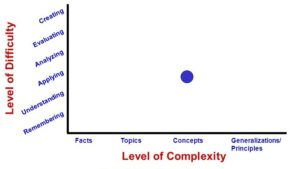Written by Anna Murphy
Concept-based curriculum (CBC) is an approach to curriculum design that moves away from subject-specific content and instead emphasizes “big ideas” that span multiple subject areas or disciplines. For example, in a CBC classroom, students may study the big idea of “change” in a variety of areas, from patterns in mathematics, to civilizations in social studies, to life cycles in science.
According to H. Lynn Erickson, CBC affirms that the “key to intellectual development is synergistic interplay between the factual and conceptual level of thinking.” What is synergy? “Synergy refers to an interaction where the sum effect is greater than the acting agent alone.” In a concept-based curriculum, students acquire and process factual information through the conceptual level of thinking.
The impetus behind CBC is preparing students for the 21st century by encouraging them to think at a higher level and understand the so what of what they are learning. After all, the 21st century needs students who can think conceptually.
“Conceptual thinking requires the ability to critically examine factual information; relate to prior knowledge; see patterns and connections; draw out significant understandings at the conceptual level; evaluate the truth of the understandings across time or situations; and, often, use the conceptual understanding to creatively solve a problem or create a new product, process, or idea.”
The Three Dimensions of Concept-Based Curriculum
CBC contrasts more traditional approaches to teaching and learning, which can be more surface level, with stronger emphasis on rote memorization of facts and concepts rather than their application. In a more traditional classroom, a teacher may teach a specific war by focusing on key facts and individuals, and require students to write a paper and take a test to demonstrate understanding. Conversely, CBC is a 3-dimensional approach that melds what students will KNOW, DO, and UNDERSTAND.
What does this mean? For example, in an elementary Social Studies unit, CBC unit goals extend the content and skills:
- Students will identify the Axis and Allied powers...in order to understand how 20th century conflict continues to politically and economically impact us today.
- Students will compare and contrast the environmental characteristics of the United States…in order to understand the environmental impact humans reap.
Moreover, the CBC approach pushes educators to address the central question: Why should students know or be able to do something?
Integrating Concept-Based Learning into Curriculum
CBC necessitates higher order thinking to create synergy between lower and higher levels of cognitive work. Concept-based curriculum is the evolution of facts to theory:
Facts — Topics — Concepts — Principle Generalization — Theory
Therefore, the ideas are often broader and cross-curricular. Concepts are transferrable and interact across subjects to push students to the generalization and theory level.
The good news is that many approaches to curriculum already seek to impart students with higher levels of thinking. Erickson discusses CBC from the perspective of Understanding by Design (UbD) so we will focus on CBC from that lens—but don’t worry, we’ll discuss CBC as it relates to other pedagogies below!
Template Examples for Designing Your Curriculum Map
Spark inspiration for next-level curriculum design with curriculum map examples from schools and districts across the world.
The Concept-Based Curriculum Framework (An Ode to UbD)
CBC parallels backwards design. Teachers integrating CBC into their classroom must first think of the higher-level knowledge they want students to gain from instruction. Instruction can be at the unit or course level—or better yet, both! Concepts arise at the unit level but can have an overarching course-level theme.
Think synergy. Developing CBC starts with the higher level knowledge students will gain (the Enduring Understandings and Essential Questions) and then moves to the more topical content and skills that will inform the higher level thinking. Next is identifying how this will be assessed, and determining what mix of assessments will successfully encourage students to think and operate on a conceptual level. Finally, developing CBC moves to the more tactical resources and activities that will be used simulate concept-based instruction.
Example of a concept-based curriculum unit planner:
 Getting to Concept-Based Curriculum
Getting to Concept-Based Curriculum
We’ll say it again, CBC is about getting students to a higher level of thinking. Students will know/do in order to understand…
So, as you work through your unit planning, consider the evolution of skills and content students will need to achieve this level of thinking. More good news…a lot of this leg work has already been done. Webb’s DOK Levels and Bloom’s Taxonomy offer examples for how student’s skills can grow in order to reach higher levels of thinking. Synergy!
Erickson offers an example of how the CBC structure of knowledge works in tandem with Bloom’s Taxonomy:

Moreover, as students move through different levels of learning, they are also achieving higher levels of knowledge. For example, a concept-based approach will also change the questions we want students to ask throughout units. Let’s return to our earlier example in an elementary Social Studies unit:
- A factual question would be: What was the Cold War?
- A conceptual question would be: What are examples of prolonged conflict and war currently?
- An essential question would be: How do we define conflict?
This level of questioning embodies the journey of students from fact to theory. The integration of factual and conceptual should be a design goal for instruction.
Concept-Based Curriculum and Other Pedagogies
While CBC is an approach to curriculum design that could have its own unit planner, it also melds well with other pedagogies. CBC can be reflected across different approaches to curriculum so long as the curriculum aims to drive students to higher order thinking that grows year to year and is transferrable across subject areas.
For example, Montessori is similar to CBC in that it is also student-driven. Create a conceptual classroom or unit theme and encourage students to relate their work back to it.
Similarly, in an International Baccalaureate context, connect student inquiry to key concepts and overarching themes. At the Diploma Programme level, utilize transfer goals as a place to document the transferrable concepts and understandings (rooted in skills and knowledge) that the units will impart.
In systems such as the IGCSE or AS/A levels, CBC can improve student cognition of aims and assessment objectives by giving students real-life application and higher-level understanding
Concept-based curriculum is a robust approach to curriculum design. The information shared here is derived from H. Lynn Erickson’s book Concept-Based Curriculum and Instruction for the Thinking Classroom. As you consider adapting your curriculum to a concept-based approach, remember synergy and higher-level thinking: synergy between different aspects of curriculum and a constant drive to help students see the bigger picture, make connections and inferences, problem solve, and self-reflect in order to think conceptually and apply their learning at a high level.
Learn more about designing curriculum templates to support teaching and learning at your school.
[et_pb_cta button_url="https://www.onatlas.com/features#atlas" url_new_window="on" button_text="Learn More About Atlas" _builder_version="4.9.0" _module_preset="default" background_color="#FFFFFF" custom_button="on" button_text_color="#FFFFFF" button_bg_color="#d23831" background_layout="light" width="85%" module_alignment="center" custom_margin="||||false|false" custom_padding="12px||12px||false|false" border_radii="on|12px|12px|12px|12px" border_width_all="5px" border_color_all="#d23831"]
Want to learn more about how Atlas can help you in documenting curriculum? Request a free demo or email us at [email protected]!
[/et_pb_cta]
